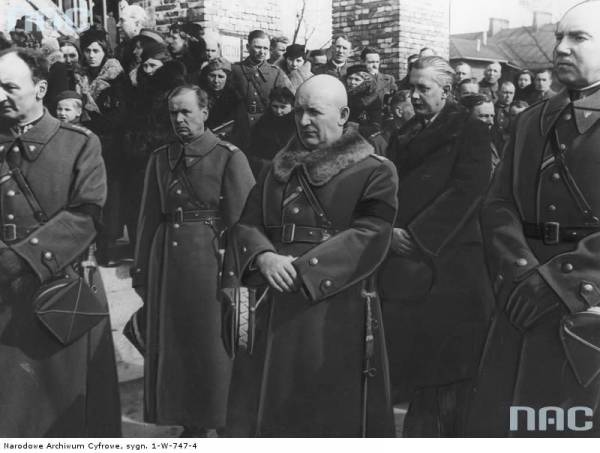GENERAL STANISLAW KOZICKI
In the July 2016 edition of Leominster News Councillors Felicity Norman, Deanne Evans and Clive
Thomas deplored instances of abusive
behaviour towards foreign people following the Brexit referendum. The largest group of people to settle here in
recent years has come from Poland. But
in nearly every part of the country you will find descendants of Polish people who
came here during and after WW2. I said descendants but of course there are
still some of the original people still alive including a wonderful woman who
lives near me.
The Battle of
Britain is often portrayed as a lone British struggle but other nationalities
were involved, the largest contingent being Polish. Two squadrons were entirely Polish and Polish
pilots flew in other squadrons as well.
303 Polish Squadron had the highest Hurricane Squadron hit rate of them all. One of the reasons for this was that their
pilots were more battle hardened having unsuccessfully fought the Nazis in
their own country and desperately wanting to retaliate.
Air Chief
Marshal Sir Hugh Dowding, who led Fighter Command wrote -
"Had
it not been for the magnificent material contributed by the Polish squadrons
and their unsurpassed gallantry, I hesitate to say that the outcome of the
Battle would have been the same."
In other words
their contribution was critical. It is ironic therefore that although we
declared war in 1939 in support of Poland, Polish forces were excluded from the
London victory celebrations in 1946 because of fear of antagonising Stalin –
political correctness.
In 2012 I heard about Polish graves in Leominster
cemetery. When I investigated I found 7 graves, all of soldiers who seem to
have died at Barons Cross Hospital in 1947 or 1948. Some graves were in
reasonable condition but I nearly overlooked one which had sunk and on which
the writing was obscured by soil and vegetation. It was the most neglected looking of them all. Carefully clearing this I read in English -
TO THE MEMORY OF MAJOR GENERAL STANISLAW
KOZICKI POLISH ARMY
DIED JULY 13 1948 AGED 55 YEARS.
From several sources I pieced together the following information.
He was born in
Lviv which is now in Ukraine. At first he was in the Austro-Hungarian army and
later joined the Polish army where he rose to high rank finally becoming Head
of the Armed Forces Department in the Polish War Ministry. In 1938 he returned home after some weeks
away to find that his wife, Helenam 5 year old daughter Alice, her 16 year old tutor Zofia and
their 18 year old maid Jozefa, had all been bludgeoned to death. His batman had done this to cover up a theft
and was found a few days later and committed suicide with a pistol he had
stolen from the General. There is a
photo of the general at the funeral which I found in an online copy of a Polish
newspaper of the time.
General Kozicki at the funeral of his wife and daughter 1938
When Polish
forces surrendered in September 1939 along with thousands of others he crossed
the border into Romania. (Poland and
Romania then had a common border). The
Kingdom of Romania interned him from September 1939 until February 1941. When
Romania came under Nazi influence he was made a prisoner of war in Germany
first in Stalag VI E in Dorsten and then in Stalag VI B in Dössel. It is said that he behaved with great
dignity as a prisoner and annoyed the Germans by his anti-Hitler stance.
GRAVE OF GENERAL STANISLAW KOZICKI IN LEOMINSTER CEMETERY
The following
is written in English around the grave.
TO THE MEMORY OF MAJOR GENERAL STANISLAW KOZICKI
POLISH ARMY DIED JULY 13 1948 AGED 55 YEARS
This grave is relatively new presumably erected after the death of Dr Tumidajski's wife. Like him she was born in what is now Ukraine and very nearly made it into the new century dying on December 13th 1999.
There are many questions concerning these graves. Four are military ones and so I presume that these men were serving military when they died and the other
three, including the General were no longer serving soldiers. It is quite possible that all seven were not
in Britain during WW2 but came after the war on resettlement programmes. Despite the reason for us going to war these men either could not or did not wish to return to their homeland because of the new political situation.
I
obtained from Hereford copies of the death certificates of four of these men
but Hereford does not have those of the other three. Where are they? Might it be possible to trace relatives?





